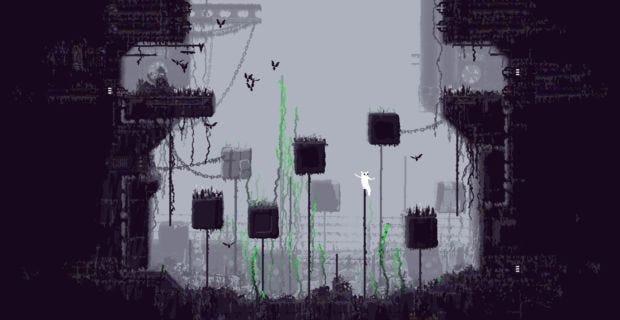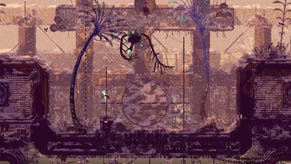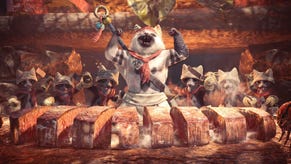Wot I Think: Rain World
The 5175th series of Planet Earth
A trickle of wholesome GIFs has been tantalising us with post-apocalyptic platformer Rain World [official site] and its adorable protagonist the slugcat for some time now. It’s out tomorrow and I have been hopping and swimming and munching my way through its dripping, humid world of predator and prey over the past week to tell you wot I think. First: I am certain it’s going to become a cult hit with a crowd of hardcore, mystery-loving obsessives behind it. But secondly, it has also left me with the impression of a badly missed opportunity. Equal parts astounding and hands-tearing-out-your-hair frustrating, this adventure, like the slugcat itself, is a bit of a mix.
The story is all it needs to be – you are a slugcat who has been separated from your family. Off you go into this unsettling world of narrow drain pipes and soggy piles of garbage to find them. You need to eat to survive and avoid being eaten by the various hissing lizards and fearsome critters that prowl from screen to screen looking to fill their own stomachs.
The blue fruits hanging from vines and bats that flutter about are your first introduction to the dining rituals of the slugcat, but there are many more types of food. There’s no constantly-depleting survivalist meter as such, just a line of seven pips that fill with each morsel (the pips aren’t “health” or “stamina” but they do empty in another way, which I’ll talk about later). Like much of the game, I’d rather avoid talking too much about those later foodstuffs, because discovering exactly what they are and how to eat them is part of the game’s sense of animalistic curiousity, one of its greatest strengths. And you will have to discover most of these for yourself, because this is a game that, notwithstanding the first few screens, absolutely loathes explaining itself.
That makes talking about its virtues much harder for me. I'm avoiding screenshots of many animals because it's best in its surprising moments. When you suddenly spot a new type of beast appearing out of a hole in the ground and run to the other side of the screen in a panic. Or when you finally understand what those little blue seedlings are for. Or when a creature you thought was dangerous, actually turns out to be more or less harmless so long as you leave it alone. If there’s a puzzle element to the game (and it’d be a stretch to say that there is) it’s in figuring out how the whole food chain fits together and what your place is in it. Who eats who? What are these fruits good for? What do I do with this pearl?
In its revelatory moments, or in moments of sheer drama (avoiding camouflaged beasts in a tunnel system, catching a glimpse of a black tail in a tank of deep water) Rain World really does shine. The world is a huuuuuuge collection of screens and environments, each with particular threats and obstacles. Each area is woven together by bolt holes, and you can see a multi-layered map of everything you’ve uncovered by holding down a shoulder button.
There’s some direction in the form of small eye-creatures that appear like weeds out of crevices in the rock or rusted metal. They will point you towards bats or fruits, and sometimes flash an image of a slugcat by a bolt hole (suggesting that they might know which way your family has gone) or some other mysterious image. However, their directions become less and less frequent as you go on, I found. Regardless of their directions, the desire to explore every region as fully as possible will infect you. Overcoming pitfalls and puzzling at dead ends is all part of being a lost animal in this weird place. But obviously, there is a bigger threat than lizards and unknown beasts: the rain.
This comes periodically. I never timed it, but it felt like maybe every fifteen minutes or so. After a while, you get a sense for when rainfall is near. A little meter in the bottom left is telling you this, a cricle of dots ticking down to zero (not that the game offers you this information). But you also know when rain is about to fall because the sky starts to darken and the land shakes, slowly at first, then faster. It rains in a brief shower, nothing you can’t handle. But then this stops and everything goes still. Then: “tink!” A single sharp drop of what I can only describe as “super rain”. Tink tink! Two drops. TINK TINK TINK TINK TINK. Suddenly, the screen is lost in sledgehammer water. If you’re caught in the rain, you are dead.
To survive each shower, you need to find special hibernation chambers, marked with a boxy symbol. To hibernate, you need to have eaten enough food – at least four pips worth. The hibernation process will always use up four pips of food, which means each new “morning” you are hungry again. Critically, these chambers are also your save points. And this is where it all starts to unravel for me. Because Rain World is cursed with some of the most teeth-grindingly bad checkpointing in any modern-day platformer.
The hibernation chambers are often very far apart. In theory this fits with the survivalist theme. Living “winter” to “winter” while hiding and running from vicious predators of the natural world isn’t easy. Just ask any rabbit. But in reality this means you will often be repeating the same bunch of screens numerous times only to die from a frightening creature that ambushes you out of nowhere. That’s because the other creatures are spread out at the AI’s will. Sometimes, there are none to be seen. Sometimes three predators will appear at once, blocking your way to the next area or surrounding you from multiple avenues. Sometimes you take a bolt hole into the next screen and straight into the jaws of a waiting lizard.
Other times you get caught in a game of Darwinian Pacman, trapped in narrow passages between two types of beast, both vying for your blood, with no way past either of them. It is all completely random and unavoidable. The best solution to getting past predators is often to accept death and try again – because next time they might not be in the same place. While all this replicates the brutish, nasty and short nature of the wilder-apocalypse, it makes for a frustrating platformer. Early on, the repetition of screens and areas is more forgiveable. But later you will navigate twenty or so screens only to die from some accident of fate. When you respawn, none of the map you have uncovered has been saved. This might have been Rain World's most serious crime, if you didn’t count the controls.
These are a baffling frustration. Sometimes you’ll land from a height and roll without meaning to, sometimes you’ll press down to duck into a hole and end up rolling around on the ground like a vulnerable white meatball. Very often, you will enter tunnels backwards, travelling much slower than normal (there's a way to turn around, but it too is slow). Sometimes you’ll wiggle left or right while on a pole, trying to prepare for a jump and the game will think you want to “unhook” from the pole, resulting in a lethal fall. Sometimes you’ll be legging it from a deadly creature and suddenly stick to a pole because of the way your thumbstick is angled. I can’t count the deaths I have suffered because of an annoying control issue, whether it was rolling off a tower or ducking into the wrong crevice and missing my chance to escape into a proper bolt hole.
These crevices are particularly frustrating. They are everywhere, carved into walls and the ground. Other creatures can appear from them, which is fine, because this makes it feel like your predators have their own separate system of bolt holes. But to you, they are totally useless, and worse, they get in the way. They are stubby dead ends not deep enough to hide in, yet the slugcat will start to clamber in if you are pushing the stick vaguely towards one. This would not be such a big problem, except that real bolt holes are almost always surrounded by these false nooks. Put this together with awkward, sticky controls and you will often be putting your cat’s head down the wrong hole. In split-second pursuits, this means the difference between life and death. Back to the last hibernation pod for you, kitten.
That’s just one example of the way the tar-like controls taint the sense of adventure. The process of holding and throwing objects is also weirdly inconsistent. I just wrote and subsequently deleted an entire paragraph in which I tried to explain the system of picking things up, swallowing them, regurgitating, putting them down, throwing, and swapping items between paws. I deleted it because the description was so riddled with minor details and exceptions that the paragraph read like a bizarre legal document.
“The left paw will be the thrower, insofar as there is no spear in the right paw, until such time that there is another more lethal object in the counterpaw, in which instance the thrown object will defer to the judgement of the game’s instructions, or to the nature of the object in the right paw.”
It’s a mess. Carrying a useful object ten screens to use it in a particular place, and then accidentally throwing it away just as you approach your goal, is a regular occurrence. All these problems are especially surprising because the game markets itself as having a hero with “nimble movements” and “natural fluidity”. But I cannot think of a less befitting description for this troublesome animal. It’s a shame. For a platformer bad controls can be fatal. I don’t think they outright kill Rain World’s charisma and charm, but they've definitely maimed it.
In many ways, Rain World isn’t trying to be a platformer – it is more in love with mystery and discovery and it pays equal homage to the Metroidvanias of the world. But in all the important mechanical ways, it remains tied to that ancestral genre of leaping from ledge to ledge. You need to run and jump and climb and swim and throw things, often at speed in order to escape some otherworldly nasty running behind you with its toothy maw ajar.
Yet the controls feel stubbornly designed. Sticky, surly, often uncooperative. There are so many things that would make them feel better (a higher jump, less “weight”, a more sensible way to throw, drop and swap items) and yet those considerations seemed to have been ignored in favour of a method of movement that, yes, looks sublime yet often handles horribly.
People will look at the toughness and the deaths and cite Limbo as a comparison. But for me, it is much more reminiscent of Abe’s various Oddysees and Exodduses (Exoddi?) The world is gorgeous, the characters are likeable, and the enemies especially are scary and fascinating in equal measure, and are often pitted against one another in clever ways that make the landscape feel bustling with life.
But Abe too had an aggravating control scheme (although his required pinpoint precision and meticulous timing, whereas the slugcat just feels sticky). Abe too forced you to run onto new screens in a panic without knowing that there would be a pitfall or a trap waiting for you. Abe too sought pleasure in being masochistic. A carnivourous plant disguised as a pole is simply Rain World’s version of an unlabelled lever that, when pulled, crushes you beneath a giant rack of ribs. In so many ways it echoes the strengths of that lovable green farter but it also retains all the flaws, and in fact introduces whole new ones – at least Abe gave you a quicksave.
Modern platformers that want to be difficult have learned the value of a quick and nearby spawn. Fell into some spikes? Never mind, says the game, and one second later you are at the last brick wall you leapt from. The slugcat doesn’t get this treatment, instead it is transported back to the nearest save point, the last hibernation chamber. The things you have done to the environment have been undone, the parts of the map you revealed have been recovered in shroud. You are ten screens back from where you were, only now the predators and prey will be in different places.
It can get hugely frustrating, especially in those parts of the world where you have to navigate bothersome pools of leeches, or wall-jump up long shafts, or seek out a certain object before facing an otherwise impossible obstacle. Having to repeat these areas doesn’t feel like an exercise in hardcore gaming, it just feels like a chore. Some of the areas feel like you’d need the developer’s debug tools just to get through. It’s demoralising. You want to explore the next area, encounter the next weird tentacled species. But the game does everything it can to stop you from doing this. It is astounding that, after navigating twenty or thirty screens, you will die because a random enemy has spawned off the edge of the screen, impossible to see, and snapped you up with its tongue.
The oddest thing about it is that, like the controls, this difficulty feels entirely deliberate. It is like Rain World wants to have the strength of difficulty we find in Dark Souls. But that classic of dying and re-dying had the impetus of soul currency, a sense of gambling, a sense of pace, and the relief of clever shortcuts with near-perfect geography. Not to mention the HUGELY SIGNIFICANT gesture of always putting the enemies reliably in the same place, like a solid, immovable set of spiky hurdles. You always had the means to overcome and defeat them. You just needed to learn.
Here there is only the obstacle of repeating the same awkward platforming sections over and over again, sometimes being put out of your misery by a creature that gobbles you up out of the blue or makes your intended route suddenly impassable. It takes everything platformers have learned not to do over the last 10 years and throws each lesson over its shoulder into the waste basket. It definitely gains some originality thanks to this exercise, but it is often at the expense of basic playability.
I’m wailing on it quite a lot here, which may seem unfair. But it's only because so much potential has been lost. There’s a ton of things to fall in love with. The world is vast and wonderfully drawn. The process of discovery is wonderful, and it puts an encouraging amount of trust in the player to figure things out by themselves. As for the natural world it conveys, it can feel like living through a surreal season of BBC's Planet Earth, set thousands of years after mankind's demise. I have had run-ins with animals that have made me shiver, squeal or grin from ear to ear. A particular creature was so instinctively frightening that I had to take a short break to regain my courage before taking the slugcat on a long swim across some open water. He did not survive.
And there’s depth here too. Creatures and mysterious personas are hidden at the extremities of the map, offering some small aid or boost, although you might not know how or why they do so until much later. There’s a method of travelling vast distances and it takes some experimentation to figure this system out. You might put something in your gullet and forget all about it, only for it to become suddenly very helpful two regions later, where you can vomit it up and put it to use. And these are just the details I figured out. There’s much more that I’d love to discuss with another player – what do those little [REDACTED] do? Did you visit the [REDACTED] with all those terrifying [REDACTED]? And – oh my god - what exactly are the consequences of eating the [REDACTED] by that [REDACTED]?
I’m at a disadvantage with the review copy, see, since I don’t have the sanctuary of discussion threads or friends who’ve already clocked it to relieve my most pressing confusions, unlike y’all. It’s a game that I think will benefit from that out-sourcing of help, the many hands and many eyes of the internet making up for the lack of in-game teachings (although, being honest, it feels like it could have benefited from more voices in the testing phase too – maybe one of them would have said: “Uh, don’t you think the controls are a bit wonky?” or “Maybe we should, like, lay off”).
So I don’t want to rubbish the experience too much. Apart from the mysteries and secrets, there is a cracking array of vicious wildlife on show here, and their accompanying methods of predation can be as impressive as they are unsettling. It often feels like a real, brutish ecosystem. Even if the AI sometimes acts weirdly, spasming in a corner, or twirling around in endless circles, it still seems earthly, red in tooth and claw, but also alien and unknown. Finding out exactly how that aquatic animal feeds or which sub-species of lizard acts in which manner is a joy. I just wish I could do that without having to repeat the same swim through cramped and flooded tunnels for the fifth time. Or the same protracted run across the ultra-dark [REDACTED], with, yes, a shelter at the end but also a perilous drop that undoes everything you just did.
I feel like time and the fans will absolve it even of its awkward controls and terrible checkpointing. But in the same way that Dark Souls drop-outs often lament that they cannot explore Lordran in some sort of easy mode, I wish that Rain World was not so obtuse and punishing. Unlike Dark Souls, there’s no real reason behind the difficulty, no sense of purposeful design. And often there is evidence of some terrible design. Why are there poles drawn in the background, in almost exact same hue as the foreground's ‘usable’ poles? Why does the ‘transition’ point from one screen to another sometimes land in critical areas – during a dangerous jump or (in one case) a winding vertical climb infested by invisible lizards, who snap you up from unseen positions far above the edge of your view. How it expects you to see the creatures before you are even on the next screen, I don’t know. Attention game makers: there is a difference between in being "hands off" and being straight-up neglectful.
Mostly, the feeling I have come away with is frustration. The philosophy here isn’t “we refuse to hold your hand”. It’s more like: “we are going to cover your hands with lubricant and task you with climbing a fireman’s pole”. The game doesn’t seem to realise that it’s strength isn’t in difficulty, or repeating areas again and again, but in discovery and wandering, in exploration and a sense of wonder.
At 20 hours, having discovered just 8 of the regions, I threw the gamepad aside with a mixture of exasperation and disappointment. There are those who will relish the challenge but I never found the slugcat’s family, and not just because there were no clues or direction as to their whereabouts. There was a big part of me that didn’t want to stop playing and maybe I’ll pick it up again some day, because there is so much to love about discovering the laws of nature behind this huge, ruined ecosystem. But with each random death, each accidental roll off a cliffside, each checkpoint drought, that love turned to ash. There is so much beauty and intrigue and diversity of life in Rain World. It’s a pity the game doesn’t want you to see any of it.
Rain World is out March 28th for Windows via Steam for £15/$20/€20.































